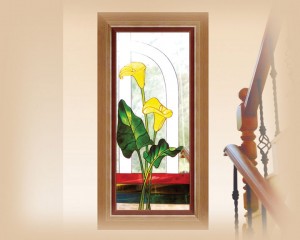-
Architectural Stained Glass
June 2008
by Simon Dean | Photographs Courtesy: Kent
Architectural stained glass is an old world invention. However, where once this skillful craft was used to adorn only the buildings of the wealthy, the royal and the sacred, today it is far more accessible and can be seen across the full architectural spectrum.

This striking design could be incorporated into a door to add a touch of style to an otherwise mundane part of a house.

This stained glass window not only lets in natural light to illuminate the staircase, but also provides an attractive focal point as you climb the stairs.

Here, stained glass has been used as an interesting way of bringing in light whilst obscuring the view through the glass for privacy, negating the need for curtains.

Stained glass is used to give a splash of colour to an otherwise ordinary corner, allowing in natural light without compromising privacy.
Typically, most people think of stained glass in relation to church buildings – great works of art depicting scenes from the Bible. But today, stained glass can be found almost anywhere, whether used to give a home that personal, stylish touch; to  provide the reception area of a hotel with a magnificent focal point, or as a convenient way to add light to a restaurant – the use of stained glass has now moved on from being a mere decorative touch, and is used in the quest to find better solutions to building problems.
provide the reception area of a hotel with a magnificent focal point, or as a convenient way to add light to a restaurant – the use of stained glass has now moved on from being a mere decorative touch, and is used in the quest to find better solutions to building problems.
There are a number of different types of stained glass. Sheet glass – literally whole sheets of coloured glass; Lead glass, where individual pieces of coloured glass are soldered together using lead – much like a jigsaw puzzle – to make an overall design; and then there is glass beveling where the edges of a piece of glass are cut. This gives a three dimensional element to the glass and can be used to produce a more interesting frame, or perhaps a motif which can be incorporated into an overall design. Glass can also be painted over using either stain glass powders or liquid stains which are then fired in a kiln to make them permanent. This is used when intricate designs or detailed pictures are required.
Stained glass can be made use of in a number of different ways:
Stained glass panels can be used to divide spaces tastefully, when privacy needs to be maintained without the bulk of the wall mass or solid partitioning. Glass panes with pleasing designs that will not allow full view of the other side adds the advantage to an uninteresting work place or restaurant. Decorative window or door panes inside houses are a tactful way to screen rooms from guests.
As much as it becomes a space divider, stained glass panels can also work as space connectors. Lengthy motifs on tall glass panes across vertical voids reinforce the connectivity of space through the voids and double-height spaces in a building.
Stained glass is best used where there is substantial light falling on the particular glass pane and is very effective in places where sunlight is needed but the view from interior to the outside is best avoided.
Stained glass panes with carefully selected colours and patterns can be very effective in architectural spaces where too much light and glare comes in. The light filtered through the glass panes can be directed through the design to fall onto various surfaces such as walls, floors and water, to make impressive patterns and images.











